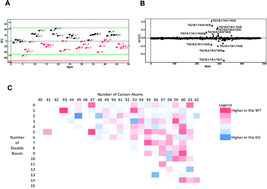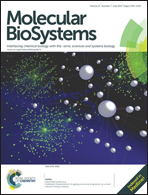A metabolomic study of adipose tissue in mice with a disruption of the circadian system†
Abstract
Adipose tissue functions in terms of energy homeostasis as a rheostat for blood triglyceride, regulating its concentration, in response to external stimuli. In addition it acts as a barometer to inform the central nervous system of energy levels which can vary dramatically between meals and according to energy demand. Here a metabolomic approach, combining both Mass Spectrometry and Nuclear Magnetic Resonance spectroscopy, was used to analyse both white and brown adipose tissue in mice with adipocyte-specific deletion of Arntl (also known as Bmal1), a gene encoding a core molecular clock component. The results are consistent with a peripheral circadian clock playing a central role in metabolic regulation of both brown and white adipose tissue in rodents and show that Arntl induced global changes in both tissues which were distinct for the two types. In particular, anterior subcutaneous white adipose tissue (ASWAT) tissue was effected by a reduction in the degree of unsaturation of fatty acids, while brown adipose tissue (BAT) changes were associated with a reduction in chain length. In addition the aqueous fraction of metabolites in BAT were profoundly affected by Arntl disruption, consistent with the dynamic role of this tissue in maintaining body temperature across the day–night cycle and an upregulation in fatty acid oxidation and citric acid cycle activity to generate heat during the day when rats are inactive (increases in 3-hydroxybutyrate and glutamate), and increased synthesis and storage of lipids during the night when rats feed more (increased concentrations of glycerol, choline and glycerophosphocholine).


 Please wait while we load your content...
Please wait while we load your content...